| Figure 1: Percentages of Articles on Open Access by Content Category and Journal Type Published in Scholarly LIS Literature, 2000-2005 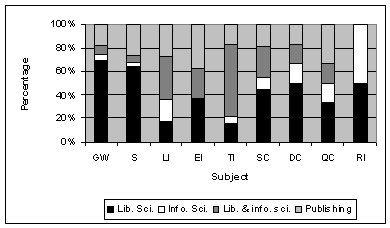
|
Texas A&M University United States zliu@tamu.edu | Texas A&M University United States gwan@tamu.edu |
ABSTRACT: This study is to analyze the publication trends of scholarly journal articles on open access in the library and information science literature from 2000 to 2005. The authors used the method of content analysis to systematically analyze the selected scholarly articles. A total of 227 articles were selected from the relevant databases and a comprehensive bibliography on open access. They were subject to a content analysis according to a classification scheme developed by the authors. It was found that general works, library science journals, viewpoint articles, library professionals, and U.S. authors predominated in the categories under investigation. Cross-tabulations of content with other categories and individual journals' productivity were also discussed.
I. Introduction
Open access is a widely debated issue in the scientific community, library world, and publishing industry. As defined by the popular "Budapest Open Access Initiative," it refers to free online availability of scholarly articles which users can "read, download, copy, distribute, print, search, or link to the full texts of these articles, crawl them for indexing, pass them as data to software, or use them for any other lawful purpose, without financial, legal, or technical barriers other than those inseparable from gaining access to the Internet itself" (Budapest Open Access Initiative, 2002). Currently, open access journals and self-archiving are the two principal strategies for open access resources. As the open access movement continues to evolve, there has been a surge in publications on this emerging phenomenon in recent years. Researchers have followed the publications on open access closely with literature reviews and bibliographies. These studies are significant in several ways. First, they inform authors and researchers of the historical development of the open access scholarship as well as the current issues that need to be addressed, thus helping them advance knowledge in this area. Second, librarians can benefit from the studies in terms of better understanding the related issues that have direct impact on their professional services such as serial subscriptions, copyright, and institutional repository. Third, the studies are also important to people in publishing business that have an interest in the development of the movement. Fourth, administrators and policy makers may find these studies useful in helping them make decisions on issues such as research fund allocation and institutional repository.
However, to the best knowledge of the authors, there is a lack of quantitative studies of the open access literature. Quantitative methods are commonly used to assess research trends in many disciplines. The present study is such an effort to fill this gap for the recent literature on open access in the library and information science literature. The value of this study lies in its quantitative perspective on the trends of publication of open access in the world of library and information science, which can help people better understand the current research trends in this area and provide certain guidance for future studies.
II. Literature Review
Several studies have been devoted to the literature or surveyed resources on open access. Mike McGrath (2002a, 2002b) gave updates on the development of open access as part of his literature reviews on interlibrary lending and document supply. Rob Kling (2004) examined the phenomenon of unrefereed scholarly publishing on the Internet with an emphasis on disciplinary archives and emerging publishing models. Focusing on the current trends of information access in developing countries, Leslie Chan and Sely Costa (2005) studied the resources on open access, especially those concerning developing countries. They recognized the great benefits open access could bring to developing countries through open access journals as well as open access archives, and suggested that knowledge workers participate in the global knowledge commons to facilitate the North-South information flow. Hanna Kwasik and Pauline O. Fulda (2005) incorporated the important online resources on open access in a webliography that highlighted the historical development of the movement, organizations supporting open access, open access publishers, digital archives, technology, and legislation. Another webliography was created by Adrian K. Ho and Charles W. Bailey Jr. (2005) who presented a wealth of useful Internet resources on open access, including general information, bibliographies, directories of journals and archives, copyright issues, publishing, technology, projects, and publishers and distributors. Charles W. Bailey Jr. (2005) published another bibliography, which had a comprehensive coverage of resources on this topic. Finally, in a recent study, M. Carl Drott (2006) presented a thorough and balanced review on open access. Starting with a discussion of the definitions, he focused on causes of open access, the journal publishing process, the role of archiving in open access, economic, technical, and legal issues involved, organizations supporting the movement, and developing trends in the area.
While the studies of open access mentioned above have provided insightful overviews of its concept, development, issues, and trends, the present study takes a different approach to this issue. It offers a content analysis of scholarly journal articles published in the library and information science literature between 2000 and 2005. Specifically, this study aims to answer the following three broad research questions:
The investigation of these three questions will provide a fairly clear picture about the research and publication trends in terms of forms, thematic threads and individual journal productivity.
III. Methodology
The articles on open access chosen for this study appeared in peer reviewed journals in the library and information science literature from 2000 to 2005. Open access in its modern sense was made possible with the invention of the World Wide Web in 1990. The open access movement developed steadily during the 1990s in which important open access projects and initiatives were launched. It gained its momentum after the "Budapest Open Access Initiative" in 2002, the "Bethesda Statement on Open Access Publishing", and the "Berlin Declaration on Open Access to Knowledge in the Sciences and Humanities" in 2003. So the time period covered in this study will reflect the growth of the open access literature as the movement took off. The majority of the articles were collected from two library and information science databases -- Library and Information Science Abstracts and Library Literature. Additional articles came from Social Sciences Citation Index and Bailey Jr.'s bibliography (Bailey Jr., 2005). Where possible, search terms "open access," "open access publishing" and "self-archiving" were used for descriptor searches and title keyword searches to locate the articles from the databases.
Following Bailey Jr. (2005), the study limited the selection of articles that fell into the grey zones between open access and other related areas such as "institutional repository" and "Open Archives Initiative Protocol for Metadata Harvesting (OAI-PMH)." The limitation was based on the assumption that articles of that nature may have a focus on other areas. Only articles in the grey zones that were deemed important to open access were selected. In addition, following the common practice in content analysis of journal articles, the study only included full-length articles for analysis. Therefore, letters, news items, short commentaries, book reviews, and editorials were not considered for inclusion. Articles written in languages other than English were also excluded. The initial round of selections included 313 articles. They were tentatively and loosely selected for further consideration, following the idea that a maximum range should be given to the initial selections. After a preliminary examination of the 313 articles, 227 were chosen for analysis. Most of the removed articles came from the grey zones.
For the purpose of coding the articles, a classification scheme was developed, including the broad categories of journal type, article type, author type, country type, and content type.
Each article was classified into one of the following four journal types:
Library science journals refer to those focusing on the study of libraries and practice of librarianship whereas information science journals are those geared toward information technology, and generation, storage, retrieval, representation, and distribution of information. Library and information science journals stand between these two types of journals. Publishing was included because it is indexed in the library and information science literature for its close relation to dissemination of information and scholarly communication.
Based on the classification of article types by Liam Rourke and Michael Szabo (2002) for a content analysis, five article types were used in this study. They were:
Furthermore, all articles were classified according to author types. Only first authors were counted for the purposes.
The four author types identified were:
Finally, authors' countries of origin (based on the country in which the author's institution is located) were also identified.
Drawing on the existing literature on open access, the authors used a set of content sub-categories and each article was classified into one of them. These sub-categories included general works, stakeholders, legal issues, economic issues, technical issues, quality control, research impact, specific open access cases, and open access and developing countries. The content sub-categories are described as follows:
General works: general discussion of open access, open access journals, open access archives; open access initiatives/organizations; literature reviews/bibliographies.
Stakeholders: open access and roles and perspectives of authors, researchers, libraries/librarians, general public, publishers/editors, universities, and professional associations.
Legal issues: copyright of open access journals, open access archives, or both; legislations concerning open access.
Economic issues: business models of open access journals, open access archives, or both.
Technical issues: software, models, designs, protocols for open access journals, open access archives, or both.
Quality control: peer review of open access journal articles, self-archiving articles, or both.
Research impact: impact and citations of open access journal articles, self-archiving articles, or both.
Specific open access cases: planning and implementation of open access journals, open access archives, or both.
Open access and developing countries: open access movement and developing countries; open access journals and developing countries; open access archives and developing countries.
IV. Results
1. General Trends of Publication by Journal Type, Article Type, Author Type, Country Type, and Content Category
Trends of Publication by Journal Type
Table 1 presents the distribution of articles by journal type. Overall, there was a dramatic growth of articles across the journal types from 2000 to 2005, although there were some fluctuations. For example, articles published in the library science journals rose from 5 in 2000 to 40 in 2005 -- a seven-fold increase in number. However, the number of articles in library and information science journals dropped noticeably in 2004. Of all the journal types, library science journal was the predominant one in productivity over the years. Library science journals published 54% of the selected articles, followed by publishing journals (21%), library and information science journals (18%), and information science journals (7%).
| Journal Type | 2000 | 2001 | 2002 | 2003 | 2004 | 2005 | 2000-2005 |
| Lib. sci. | 5 | 10 | 10 | 29 | 28 | 40 | 122 (54%) |
| Publishing | 4 | 5 | 3 | 9 | 13 | 13 | 47 (21%) |
| Lib. and info sci. | -- | 1 | 1 | 16 | 6 | 17 | 41 (18%) |
| Info sci. | 1 | 2 | 4 | 2 | 4 | 4 | 17 (7%) |
| Total | 10 | 18 | 18 | 56 | 51 | 74 | 227 (100%) |
Trends of Publication by Article Type
Table 2 presents the distribution of articles published by article type. During the six-year period, viewpoint articles grew steadily whereas articles of other types, though increasing generally, had ups and downs with the most obvious decrease in descriptive articles in 2004 and 2005. A comparison of the numbers of articles published in 2000 and 2005 revealed an appreciable increase for almost all article types. Descriptive articles were prevalent between 2000 and 2002, climbed to its highest point in 2003, but plunged in 2004 and 2005. On the other hand, the obvious increasing trend shifted to viewpoint articles between 2003 and 2005. In terms of the overall productivity for the study period, viewpoint articles were the predominant type. As shown, viewpoint articles made up 45% of the published articles. They were 1.76 times as many as descriptive articles and more than twice as many as empirical articles.
| Article Type | 2000 | 2001 | 2002 | 2003 | 2004 | 2005 | 2000-2005 |
| Viewpoint | 3 | 5 | 5 | 22 | 25 | 42 | 102 (45%) |
| Descriptive | 7 | 8 | 6 | 20 | 8 | 9 | 58 (25%) |
| Empirical | -- | 5 | 4 | 11 | 14 | 15 | 49 (22%) |
| Methodological | -- | -- | 1 | 2 | 4 | 5 | 12 (5%) |
| Review | -- | -- | 2 | 1 | -- | 3 | 6 (3%) |
| Total | 10 | 18 | 18 | 56 | 51 | 74 | 227 (100%) |
Trends of Publication by Author Type
Table 3 presents the distribution of articles published by author type. There was a general upward trend of publication across these years. However, like the trends revealed previously, the growth was gained not without fluctuations. The number of articles published by library professionals in 2005 increased by 600% compared with that published by the same author group in 2000. Likewise, articles published by academics in the same two years increased by 475%. Higher increases in articles were also found for other author types. However, noticeable interruptions of this upward trend occurred in 2002 and 2004 due to the drop in the number of articles produced by library professionals. Taken as a whole, library professionals were more productive than authors of other types in all the six years except in 2002. They were particularly productive in 2001, 2003, and 2005. Library professionals and academics were the two largest groups of first authors of the articles, making up 44% and 32% of the total respectively. Publishing professionals and other authors each accounted for 12% of the total.
| Author Type | 2000 | 2001 | 2002 | 2003 | 2004 | 2005 | 2000-2005 |
| Lib. profs. | 5 | 10 | 7 | 24 | 19 | 35 | 100 (44%) |
| Academics | 4 | 4 | 8 | 17 | 16 | 23 | 72 (32%) |
| Publg. profs. | -- | 3 | 3 | 6 | 8 | 7 | 27 (12%) |
| Other | 1 | 1 | -- | 9 | 8 | 9 | 28 (12%) |
| Total | 10 | 18 | 18 | 56 | 51 | 74 | 227 (100%) |
Trends of Publication by Country Type
Table 4 shows the distribution of articles published by country type. During the study period, there was a steady increase in first authors of articles for all country types. Again, some fluctuations occurred nonetheless. The most noticeable fall was for articles published by U.K. authors in 2005. On the other hand, it is worth noting that most of the first authors were from the English-speaking countries. Articles published by U.S. authors were 2.6 times as many as those by U.K. authors, 4.2 times as many as those by European authors, and 7.2 times as many as those by Canadian authors.
| Country | 2000 | 2001 | 2002 | 2003 | 2004 | 2005 | 2000-2005 |
| U.S. | 9 | 12 | 11 | 24 | 23 | 44 | 123 (54%) |
| U. K. | -- | 2 | 4 | 16 | 16 | 9 | 47 (21%) |
| Europe | -- | -- | 2 | 9 | 8 | 10 | 29 (13%) |
| Canada | 1 | 2 | 1 | 5 | 3 | 5 | 17 (7%) |
| Others | -- | 2 | -- | 2 | 1 | 6 | 11 (5%) |
| Total | 10 | 18 | 18 | 56 | 51 | 74 | 227 (100%) |
Trends of Publication by Content Category
Table 5 presents the distribution of articles published by content category. Similar to the trends identified previously, articles by content category showed a general increasing trend over time with fluctuations. Comparing the numbers of articles published in 2000 and 2005, the greatest increase was that for stakeholders among all content sub-categories. General works increased by 400% in the same two years whereas specific cases increased by 125%. General works was the largest content sub-category, making up 32% of the selected articles. The second largest sub-category was stakeholders which accounted for 22% of the total, followed by that of specific cases (21%). Shares of articles in other aspects of open access such as legal issues, technical issues, business models, quality control, research impact, and developing countries, were smaller than that of the predominant ones mentioned above. General works prevailed in 2000, 2002, 2003, and 2005 whereas specific cases and stakeholders took the largest shares in 2001 and 2004 respectively.
| Content | 2000 | 2001 | 2002 | 2003 | 2004 | 2005 | 2000-2005 |
| GW | 5 | 2 | 8 | 18 | 15 | 25 | 73 (32%) |
| S | 1 | 1 | 3 | 8 | 17 | 19 | 49 (22%) |
| SC | 4 | 10 | 4 | 13 | 8 | 9 | 48 (21%) |
| TI | -- | 2 | -- | 8 | 3 | 5 | 18 (8%) |
| LI | -- | -- | 1 | 2 | 2 | 6 | 11 (5%) |
| EI | -- | 1 | -- | 3 | 1 | 3 | 8 (3.5%) |
| RI | -- | 2 | 1 | 1 | 2 | 2 | 8 (3.5%) |
| QC | -- | -- | 1 | 1 | 2 | 2 | 6 (2.6%) |
| DC | -- | -- | -- | 2 | 1 | 3 | 6 (2.6%) |
| Total | 10 | 18 | 18 | 56 | 51 | 74 | 227 (100%) |
2. Trends of Publication by Content Category and Journal Type, Article Type, Author Type, and Country Type
Content Category and Journal Type
The relationship between content category and journal type is shown in Figure 1. Over the years, library science journals published most articles on general works (70%, 51), stakeholders (65%, 32), open access and developing countries (50%, 3), and specific cases (46%, 22). Information science journals tied with library science journals in publishing articles on research impact (50%, 4). Library and information science journals published most articles on technical issues (61%, 11) and legal issues (36%, 4) whereas publishing journals tied with library science journals in publishing articles on economic issues (37.5 %, 3) and quality control (33.3%, 2) respectively.
| Figure 1: Percentages of Articles on Open Access by Content Category and Journal Type Published in Scholarly LIS Literature, 2000-2005 
|
Content Category and Article Type
Figure 2 shows the relationship between content category and article type. Viewpoint articles were the predominant article type in covering most of the content sub-categories. For example, they accounted for 67% (49) of articles on general works, which were 5.4 times as many as the descriptive articles (12%, 9), and 61% (30) of articles on stakeholders, which were twice as many as empirical articles (30.6%, 15). While empirical articles appeared in all the content sub-categories, they were especially visible in the sub-category of research impact (88%, 7) and tied with descriptive articles in technical issues (28%, 5). Furthermore, 81% (39) of articles on specific cases were of descriptive article type. Finally, neither methodological article nor review article was a major article type for any content sub-category.
| Figure 2: Percentages of Articles on Open Access by Content Category and Article Type Published in Scholarly LIS Literature, 2000-2005 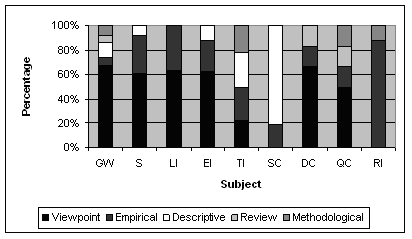
|
Content Category and Author Type
Figure 3 presents the percentages of articles by content category and author type. Library professionals contributed most in the sub-categories of specific cases (56%, 27), stakeholders (45%, 22), and general works (41%, 30). In comparison, academics contributed most in quality control (67%, 4), research impact (63%, 5), legal issues (55%, 6), technical issues (50%, 9), and open access and developing countries (50%, 3). Publishing professionals and library professionals had the largest shares in economic issues with 37.5% (3) of the articles for each group.
| Figure 3: Percentages of Articles on Open Access by Content Category and Author Type Published in Scholarly LIS Literature, 2000-2005 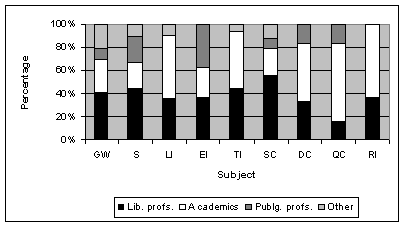
|
Content Category and Country Type
As shown in Figure 4, U.S. authors contributed highest percentages of articles in almost all content sub-categories. U.S. authors published 55% (40) of articles on general works, which were 3.6 times as many as those by U. K. authors (15%, 11), 56% (27) of articles on specific cases, which were 3 times as many as those by European authors ((19%, 9), and 49% (24) of articles on stakeholders, which were 1.4 times as many as those by U.K. authors (35%, 17). On the other hand, U.K. authors contributed most articles on legal issues (45%, 5) and tied with Canada in contributing articles on open access and developing countries (33%, 2).
| Figure 4: Percentages of Articles on Open Access by Content Category and Country Type Published in Scholarly LIS Literature, 2000-2005 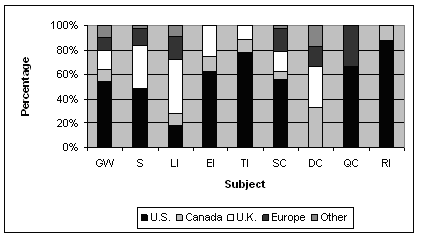
|
3. Trend of Individual Journals' Productivity
Although the selected articles have scattered in fifty-six journals, most of them have been published by a few journals. Among journals publishing the articles most during the study period were Learned Publishing (36), Information Services & Use (17), Serials Reviews (16), Library High Tech (11), Science & Technology Libraries (9), Reference Services Review (9), OCLC Systems and Service (8), Journal of Library Administration (8), and First Monday (8).
The relationship between the number of journals and the number of published articles is shown in Figure 5. It demonstrates that a few journals have published a relatively high percentage of articles on the subject whereas other journals in the set have published only a few articles each. As the distribution in the graph indicates, the top nine journals in which the articles appear most account for 54% (122) of the total.
| Figure 5: Relationship between Number of Journals and Number of Articles on Open Access Published in Scholarly LIS Literature, 2000-2005 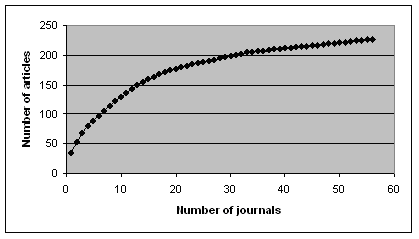
|
V. Discussion and Conclusions
Overall, there was a considerable increase in the number of published articles on open access in the library and information science literature during the study period. There appeared to be an apparent demarcation line in productivity of articles between the first half (2000-2002) and the second half (2003-2005) of the study period. The increase became exceedingly noticeable in 2003, dropped slightly in 2004, and bounced back in 2005. The continued increase in the number of published articles on open access in the library and information science literature indicates the increasing attention this movement is receiving from its stakeholders. The increase is significant because the number of articles published in 2005 is more than seven times as large as that in 2000. The noticeable increase in the publications in 2003 may be due to the influence of the three important open access initiatives (Budapest, Bethesda, and Berlin) that were launched in 2002 and 2003.
More than half of the articles were published in library science journals. Library science journals published highest percentages of articles on general works, stakeholders, open access and developing countries, and specific cases, whereas library and information science journals produced the highest percentages of articles on technical issues and legal issues. Since this study is limited to the literature on open access in library and information science, it is natural that library science journals are the predominant journal type for publishing articles on the topic. The fact that publishing journals have contributed the second largest number of articles is noteworthy, given the relative small number of publishing journals included in the study. Obviously, this is attributed to the high productivity of Learned Publishing which has contributed 36 articles alone during the study period. The result is consistent with the observation by Adrian K. Ho and Charles W. Bailey (2005).
Viewpoint articles were the predominant article type, followed by descriptive articles and empirical articles. Viewpoint articles were prevalent in almost all content sub-categories except in those of specific cases, research impact, and technical issues where descriptive articles and empirical articles appeared most frequently. The fact that viewpoint articles are the predominant research type for this topic demonstrates a popular demand for opinions on open access in recent years. Further, it is common to have reports of cases and services or "how-we-did-it-good" papers published in the LIS literature. However, the relatively low proportion of empirical studies serves as a reminder that this type of research perhaps needs more attention in the future.
Library professionals and academics were the two major author types. While library professionals contributed most in the sub-categories of general works, specific cases, and stakeholders, academics were more productive in those of quality control, research impact, legal issues, technical issues, and open access and developing countries. The focus of this study on the library and information science literature largely explains why library professionals are the largest group of authors. Academics and publishing professionals are the second and third largest author groups because, like library professionals, they have higher stakes in this movement than other people.
Most of the first authors of the articles came from the English-speaking countries and more than half of the authors came from U.S. In almost all content sub-categories, U.S. authors contributed more than authors from other countries. Since only articles in English have been selected for this study and most selected journals are based in the English-speaking countries, the language preference explains at least partially why the overwhelming majority of authors come from the English-speaking countries.
Of the nine content sub-categories used in this study, general works on open access was the predominant one whereas stakeholders and specific open access cases were the second and third largest sub-categories respectively. The number of articles in all content sub-categories, by and large, grew over time with some fluctuations in different years. The focus of current discussion of open access on general issues, stakeholders' perspectives, and implementation of specific open access cases indicates the authors' general interests in issues related to the movement and their need to express their concerns about some particular issues and share their practical experiences as librarians, authors and researchers, etc. However, it is too early to predict whether the focus will shift to other aspects of open access as the movement goes on.
In terms of individual journal productivity, the distribution of the published articles among individual journals reveals that a few journals have published most of the articles on open access during the study period. The finding about the individual journal productivity does serve as an example to show the prevalence of this phenomenon in the publishing world.
As an emerging alternative to traditional scholarly communication, open access is making its impact felt by its stakeholders to an extent that has never been seen before. The future of this new mode of scholarly communication, like many new innovations in their early stages, remains promising. It would be encouraging to see more studies in the future dealing with the key issues on open access such as its economics, technology, copyright, quality, impact, and stakeholders' perspectives. It is hoped that studies of those kinds can contribute views from different perspectives, thus helping assess the movement and shape its future.
| Liu, Zao, & Wan, Gang. (2007). Scholarly Journal Articles on Open Access in LIS Literature: A Content Analysis. Chinese Librarianship: an International Electronic Journal, 23. URL: http://www.iclc.us/cliej/cl23LiuWan.htm |